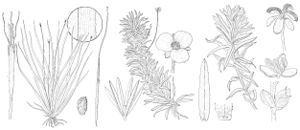Difference between revisions of "Egeria densa"
Annales des Sciences Naturelles, Botanique sér. 3, 11: 80. 1849.
FNA>Volume Importer |
imported>Volume Importer |
||
| (3 intermediate revisions by 2 users not shown) | |||
| Line 8: | Line 8: | ||
}} | }} | ||
|common_names=Water-weed | |common_names=Water-weed | ||
| + | |special_status={{Treatment/ID/Special_status | ||
| + | |code=W | ||
| + | |label=Weedy | ||
| + | }}{{Treatment/ID/Special_status | ||
| + | |code=I | ||
| + | |label=Introduced | ||
| + | }}{{Treatment/ID/Special_status | ||
| + | |code=F | ||
| + | |label=Illustrated | ||
| + | }} | ||
|basionyms= | |basionyms= | ||
|synonyms= | |synonyms= | ||
| Line 24: | Line 34: | ||
|elevation=0–500 m | |elevation=0–500 m | ||
|distribution=Ala.;Ark.;Calif.;Colo.;Del.;Fla.;Ga.;Ill.;Ind.;Kans.;Ky.;La.;Md.;Mass.;Miss.;Mo.;N.J.;N.Mex.;N.Y.;N.C.;Okla.;Oreg.;Pa.;S.C.;Tenn.;Tex.;Vt.;Va.;W.Va.;Mexico;West Indies;Central America;native;South America;Europe;Africa;Asia;Australia. | |distribution=Ala.;Ark.;Calif.;Colo.;Del.;Fla.;Ga.;Ill.;Ind.;Kans.;Ky.;La.;Md.;Mass.;Miss.;Mo.;N.J.;N.Mex.;N.Y.;N.C.;Okla.;Oreg.;Pa.;S.C.;Tenn.;Tex.;Vt.;Va.;W.Va.;Mexico;West Indies;Central America;native;South America;Europe;Africa;Asia;Australia. | ||
| + | |introduced=true | ||
|discussion=<p><i>Egeria densa</i> is native to southeastern Brazil and has been widely sold in the aquarium trade, often becoming established in nature. Only staminate plants of <i>E. densa</i> have been observed outside its native range. Reproduction, then, occurs entirely by vegetative methods. No differentiated vegetative reproductive structures (turions, bulbils, etc.) are known (C. D. K. Cook and K. Urmi-König 1984b); however, the species is known to live temporarily under ice. The leaves of <i>Egeria densa</i>, which are only two cell-layers thick, are much used to demonstrate plant-cell structure and cytoplasmic streaming in introductory botany courses.</p> | |discussion=<p><i>Egeria densa</i> is native to southeastern Brazil and has been widely sold in the aquarium trade, often becoming established in nature. Only staminate plants of <i>E. densa</i> have been observed outside its native range. Reproduction, then, occurs entirely by vegetative methods. No differentiated vegetative reproductive structures (turions, bulbils, etc.) are known (C. D. K. Cook and K. Urmi-König 1984b); however, the species is known to live temporarily under ice. The leaves of <i>Egeria densa</i>, which are only two cell-layers thick, are much used to demonstrate plant-cell structure and cytoplasmic streaming in introductory botany courses.</p> | ||
|tables= | |tables= | ||
| Line 33: | Line 44: | ||
-->{{#Taxon: | -->{{#Taxon: | ||
name=Egeria densa | name=Egeria densa | ||
| − | |||
|authority=Planchon | |authority=Planchon | ||
|rank=species | |rank=species | ||
| Line 48: | Line 58: | ||
|publication title=Annales des Sciences Naturelles, Botanique | |publication title=Annales des Sciences Naturelles, Botanique | ||
|publication year=1849 | |publication year=1849 | ||
| − | |special status= | + | |special status=Weedy;Introduced;Illustrated |
| − | |source xml=https:// | + | |source xml=https://bitbucket.org/aafc-mbb/fna-data-curation/src/2e0870ddd59836b60bcf96646a41e87ea5a5943a/coarse_grained_fna_xml/V22/V22_512.xml |
|genus=Egeria | |genus=Egeria | ||
|species=Egeria densa | |species=Egeria densa | ||
Latest revision as of 21:31, 5 November 2020
Stems 1–3 mm diam. Leaves whorled, recurved, 10–40 × 1.5–4.5 mm. Staminate spathes 2–4-flowered, 7.5–12 mm; pedicel to 80 mm. 2n = 46.
Phenology: Flowers summer–fall.
Habitat: Shallow waters of lakes and streams
Elevation: 0–500 m
Distribution

Introduced; Ala., Ark., Calif., Colo., Del., Fla., Ga., Ill., Ind., Kans., Ky., La., Md., Mass., Miss., Mo., N.J., N.Mex., N.Y., N.C., Okla., Oreg., Pa., S.C., Tenn., Tex., Vt., Va., W.Va., Mexico, West Indies, Central America, native, South America, Europe, Africa, Asia, Australia.
Discussion
Egeria densa is native to southeastern Brazil and has been widely sold in the aquarium trade, often becoming established in nature. Only staminate plants of E. densa have been observed outside its native range. Reproduction, then, occurs entirely by vegetative methods. No differentiated vegetative reproductive structures (turions, bulbils, etc.) are known (C. D. K. Cook and K. Urmi-König 1984b); however, the species is known to live temporarily under ice. The leaves of Egeria densa, which are only two cell-layers thick, are much used to demonstrate plant-cell structure and cytoplasmic streaming in introductory botany courses.
Selected References
None.
